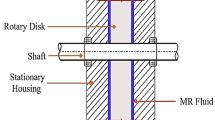Abstract
In this paper, first a new design for a disk-type magneto-rheological (MR) brake for automotive applications is proposed and then, a finite element analysis is performed to analyze the resulting magnetic field intensity distribution within the MR brake configuration. This finite element model of the brake is then utilized in a optimization process which incorporates Genetic Algorithm (GA) to obtain optimal design parameters. The optimization process goal is to increase the braking torque capacity of the brake while keeping the weight of the brake as low as possible. Although, the braking torque of the present design is larger compared to the previous designs, the braking toque capacity of the present design is still smaller than the required braking torque for automobiles.
Similar content being viewed by others
References
An, J. and Kwon, D.-S. (2003). Modeling of a Magnetorheological Actuator Including Magnetic Hysteresis. J. Intelligent Material Systems and Structures, 14, 541.
Ashour, O. and Craig A. (1996). Magneto-rheological fluids: Materials, characterization, and devices. J. Intelligent Material Systems and Structures, 7, 123–130.
Belytschko, T. and Leviathan, I. (1994). Physical stabilization of the 4-node shell element with one point quadrature. Comput. Methods Appl. Mech. Engrg., 113, 321–350.
Bydon, S. (2002). Construction and Operation of Magnetorheological Rotary Brake. Archiwum Process Control Club. Poz 20.
Bydon, S. (2003). Facility for Induction Motor Velocity Control with Magnetorheological Brake. Archiwum Process Control Club, poz 22.
Carlson, J. D., LeRoy, D. F., Holzheimer, J. C., Prindle, D. R. and Marjoram, R. H. (1998). Controllable Brake. US Patent No. 5842547. United States Patent Office.
Chaudhuri, A., Wereley, N. M. and Radhakrishnan, R. (2005). Genetic Algorithms for Rheological Parameter Estimation of Magnetorheological Fluids. Smart Structures and Materials-Active Materials: Behavior and Mechanics, Int. Society for Optical Engineering, Proc. SPIE 5761, 164.
Chciuk, M., Milecki A. and Myszkowski, A. (2009). Applications of magnetorheological brakes in manual control of lifting devices and manipulators. 11th Conf. Electrorheological Fluids and Magnetorheological Suspensions, J. Physics: Conf. Series, 149, 012042.
Chew, C. M., Hong, G. S. and Zhou, W. (2004). Series damper actuator: A novel force/torque control actuator. Proc. IEEE-RAS/RSJ Int. Conf. Humanoid Robots, Los Angeles, CA, 533–546.
Farjoud, A., Vahdati, N. and Yap F. F. (2007). Mathematical model of drum-type MR brakes using Herschel-Bulkley shear model. J. Intelligent Material Systems and Structures 19,5, 565–572.
Jolly, M. R. (1999). Pneumatic motion control using magnetorheological technology. Proc. 27th Int. Symp. Smart Actuators and Transducers, Int. Center for Actuators and Transducers (ICAT), State College, PA, USA, 22–23.
Karakoc, K., Park, E. and Suleman, A. (2008). Design considerations for an automotive magnetorheological brake. Mechatronics 18,8, 434–447.
Li, W. H. and Du, H. (2003). Design and experimental evaluation of a magnetorheological brake. Int. J. Advanced Manufacturing Technology, 21, 508–515.
Liu, B., Li, W. H., Kosasih, P. B. and Zhang, X. Z. (2006). Development of an MR brake based haptic device. Smart Materials and Structures, 15, 1960–1966.
Park, E. J., Stoikove, D., Falcao da Luz, L. and Suleman, A. (2006). A performance evaluation of an automotive magnetorheological brake design with sliding mode controller. Mechatronics 16,7, 405–416.
Park, E., Falcaõ da Luz, L. and Suleman A. (2008). ’Multidisciplinary design optimization of an automotive magnetorheological brake design. Computers & Structures 86,3–5, 207–216.
Sapinski, B. and Bydon, S. (2003). Application of magnetorheological brake to shaft position control in induction motor. AMAS Workshop on Smart Materials and Structures SMART-03, 169–180.
Song, J. (2005). Performance evaluation of a hybrid electric brake system with a sliding mode controller. Mechatronics, 15, 339–358.
Sukhwani, V. K. and Hirani, H. (2008). Design, development, and performance evaluation of high-speed magnetorheological brakes. Proc. IMechE, 222, Part L: J. Materials: Design and Applications
Webb, G. M. (1998). Exercise Apparatus and Associated Method Including Rheological Fluid Brake. US Patent No. 5810696. United States Patent Office.
Zhou, W., Chew, C. M. and Hong, G. S. (2007). Development of a compact double-disk magnetorheological fluid brake. Robotica, 25, 493–500.
Author information
Authors and Affiliations
Corresponding author
Rights and permissions
About this article
Cite this article
Assadsangabi, B., Daneshmand, F., Vahdati, N. et al. Optimization and design of disk-type MR brakes. Int.J Automot. Technol. 12, 921–932 (2011). https://doi.org/10.1007/s12239-011-0105-x
Received:
Revised:
Published:
Issue Date:
DOI: https://doi.org/10.1007/s12239-011-0105-x




